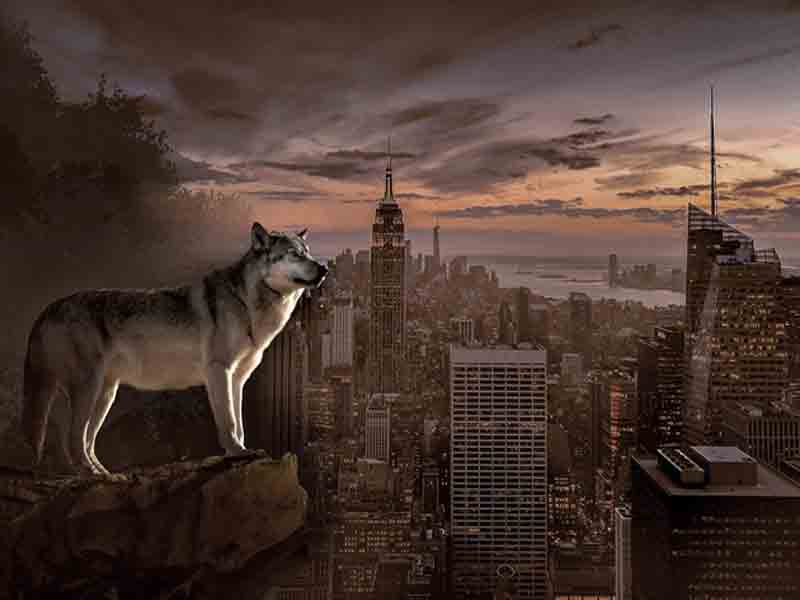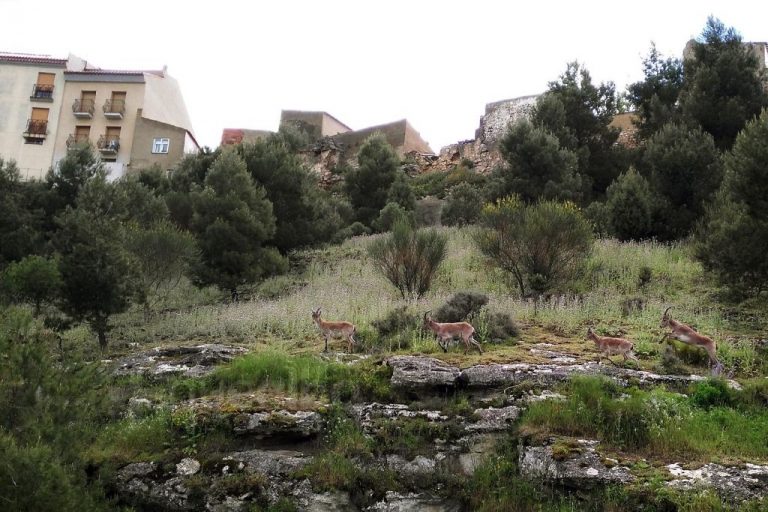Collage image of a wolf next to a big city
These days of confinement we are living due to the expansion of COVID-19, we have received some videos and images of wild animals. “They have taken the streets” we can read in various articles and posts on social networks. People, accustomed to the hustle and bustle of the city and with no time to stop in front of their windows, are stunned by the many videos they receive, showing a young bear or a wolf or deer walking into villages, even wild boars on the seafront in Spain.
Although we might think that most of these events are exceptional, in fact, many have already occurred sporadically before the quarantine. Now, less crowded cities and spending more time looking out the window allows us to be surprised by wildlife observation. Seeing wild animals in the urban area can be favoured by the tranquillity and the reduced traffic of cars and people, stimuli that tend to keep many species away from urban areas. Human life has slowed down outside, to re-emerge wild on the streets. Many of these observations are, indeed, nothing more than a compendium of events that have been brewing for a long time, such as the rural exodus and the inadequate environmental management of the urban, peri-urban, protected or not protected natural areas, hunting states, etc. Most of the animals come to cities for a long time to eat food remains that are very handy for them, in some cases they are even full-time inhabitants of this environment, in which they find everything they need. The typical peridomestic fauna has always been there, some do worse (many birds), such as sparrows, but it seems that we increasingly observe certain species that were not so common a while ago.
The case of the wild boar is of great public health concern, since they may carry different zoonotic diseases (they also affect us humans) such as tuberculosis, and may also cause damage to public areas, or even lead to injuries in the event of contact with humans. If wild boars identify the urban environment as a source of food, there is a risk that they will t more frequently, which may increase contact with people and the risk of accidents. We must not forget that it is already one of the species that causes most of the traffic accidents.
However, not only this animal is worthy of our alarm. Many wild or feral species (e.g., parrots in Spain) should not be in regular contact with people either. In addition to transmitting diseases, they might change their behaviour (for example, getting used to eating garbage when it is not normal), losing their fear of being close to humans or varying the territory they normally occupy.
Most of the threatened species will possibly not be affected by this quarantine, since they tend to inhabit highly depopulated areas. Furthermore, primary productive activities, although in some cases the movement of seasonal workers has been reduced, continue to be carried out and do not seem to have changed much. Perhaps the birds, many of them already in the reproductive season, which are more accessible and sensitive to human presence, benefit from this truce that we are going this truce people are given.
We shouldn’t fall for the hoaxes or fake news that today constitute a large part of what comes to us in the form of infinite mobile message chains, usually they are used fraudulently or inflated under the tyranny of the collection of likes and followers on social networks. We must have the ability to discern between what is true and what is false, contrasting what we see in different sources before pressing ‘share’.
Despite the abundance of erroneous messages, we have also observed how citizen science initiatives such as #yopajareoencasa in Spain are being developed, where nature observation (in this case, birds) and environmental education go hand in hand. In this way, thanks to your records, improvements can be made to the urban ecosystem.
If what you like is animal observation and contributing to the environment, when quarantine is over, remember, you can continue collaborating with our MammalNet project through the iMammalia (mobile) and MammalWeb (online) apps, to help scientists from your environment to improve their knowledge about wildlife and this is able to help it more effectively. Take advantage also of sharing from home those observations that you have previously registered, photographs on your mobile, in your photo-trapping camera, etc.
We keep in touch, mammals!



